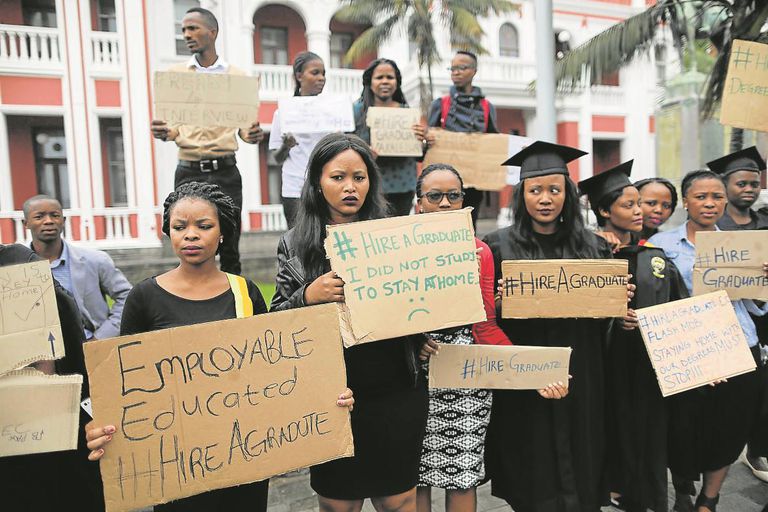
Frustrated by the pervasive youth unemployment in South Africa, educated young people, some in graduation attire, protest the disheartening paradox of being qualified yet unable to secure employment. Credit: Mail&Guardian
(The Post News)- Youth unemployment in South Africa presents one of the nation’s most pressing socio-economic challenges, a complex issue with profound implications for individuals and the country’s future prosperity. While unemployment is a global concern, youth unemployment in South Africa stands out for its severity, consistently ranking among the highest worldwide.
The latest figures from Statistics South Africa (Stats SA) for the first quarter of 2025 paint a stark picture of youth unemployment in South Africa. The official unemployment rate among young people aged 15-34 stands at a staggering 46.1%. This alarming figure represents a significant increase over the past decade, highlighting a deteriorating outlook for millions. The crisis hits younger individuals particularly hard: for youth aged 15-24, the unemployment rate soared to 62.4% in Q1 2025, while among those aged 25-34, the rate stood at 40.4% in the same period. Beyond official statistics, which already paint a grim picture, the true extent of the crisis is magnified when considering the expanded unemployment rate. This includes countless discouraged job-seekers – individuals who, after relentless searching, have simply given up hope of finding employment. Millions of young South Africans now fall into this category, signifying a widespread disengagement from the formal labour market due to a perceived lack of opportunities.
The burden of youth unemployment in South Africa is far from evenly distributed, deepening existing societal inequalities. Young women, for instance, consistently encounter greater hurdles to securing employment than their male peers. In Q1 2025, the NEET (Not in Employment, Education or Training) rate for young people aged 15-34 showed young women significantly more affected than young men. This highlights a persistent gender gap in access to work and skills development, often compounded by societal expectations and family responsibilities. Geographic location also plays a profound role, with access to opportunities heavily skewed towards urban centres. Young people in non-urban provinces disproportionately bear the brunt of economic exclusion, and the proportion of discouraged youth varies drastically by province, with some showing widespread hopelessness compared to others. While education is undeniably a crucial determinant of employability, with those holding tertiary qualifications significantly more likely to find work than those without a matric certificate, a relatively small fraction of employed youth possess degrees. This underscores that while academic achievement is vital, broader systemic issues related to education access and quality continue to fuel elevated youth unemployment.
The high levels of youth unemployment in South Africa are not isolated phenomena but rather the product of complex and interconnected factors. At its core, the crisis stems from a critical skills mismatch, persistently slow economic growth, and the pervasive challenge of young people lacking initial work experience.
A fundamental cause lies in the skills mismatch. Many young South Africans, despite years of schooling, lack the specific, practical, and technical skills demanded by modern employers. The education system often falls short in preparing students for the realities of the contemporary job market, creating a significant chasm between what job seekers can offer and what industries, particularly in digital technology and specialized trades, require. This deficiency is exacerbated by a shortage of robust, industry-aligned Technical and Vocational Education and Training (TVET) programs, leaving many youth ill-equipped for technical roles even with theoretical knowledge. Secondly, slow economic growth severely limits job creation. South Africa’s economy has consistently grown at a sluggish pace in recent years, proving insufficient to absorb the vast numbers of young individuals entering the labour force annually. This stagnant economic environment also discourages both domestic and foreign direct investment, which is crucial for establishing new businesses and expanding existing ones. Consequently, the potential for broad-based job creation, particularly for youth, remains severely constrained. Finally, the lack of initial work experience creates a “Catch-22” situation where young job seekers frequently encounter the frustrating paradox that employers demand prior experience for even entry-level positions, yet youth cannot gain this experience without first securing employment. A vast majority of unemployed youth in South Africa report having no previous work experience, illustrating the widespread nature of this barrier. There is a chronic scarcity of genuine entry-level roles, internships, and apprenticeships, making it exceedingly difficult for young people to acquire the practical, on-the-job experience necessary for workforce integration. The data reveals a stark “experience dividend”: young people with some form of work experience are significantly more likely to transition into employment than their inexperienced peers.
The long-term youth unemployment in South Africa unleashes severe social and psychological consequences that extend far beyond immediate economic losses, profoundly impacting individual lives and the very fabric of society. On an individual level, the mental health deterioration is profound. The inability to find work after years of schooling inflicts immense distress. Studies consistently link unemployment to elevated rates of anxiety, depression, and a pervasive sense of hopelessness. Alarming research indicates that a substantial proportion of youth have reported thoughts of suicide or self-harm, and a large majority feel they need mental health support. This internalisation of failure, often despite qualifications or eagerness, leads to feelings of inadequacy, shame, and guilt, particularly among those from disadvantaged backgrounds already contending with immense adversity. Prolonged joblessness can also lead to social isolation and eroding self-confidence. This disengagement, especially for youth not in employment, education, or training, often results in dissatisfaction and diminished self-esteem, trapping them in a cycle of social drift and economic inactivity. Furthermore, there is an increased risk of social problems. The idle time brought by unemployment often becomes a breeding ground for social ills. High youth unemployment is directly linked to increased rates of crime, drug and alcohol abuse, and teenage pregnancy. For many young men, involvement in violent crimes can tragically become a desperate route to identity or survival in communities where legitimate opportunities are scarce.
From a societal perspective, high youth unemployment heightens social instability. A large, disaffected, and unemployed youth population poses a significant risk to social cohesion and political stability. Frustration and grievances stemming from chronic joblessness can manifest in protests and broader social unrest, undermining democratic resilience. It also places an increased strain on social services. Widespread youth unemployment burdens the country’s social welfare systems, as reliance on government support, such as social grants, escalates, stretching already limited public resources. This leads to reduced productivity and stifled economic growth. A substantial portion of the working-age population remaining unproductive represents a massive waste of human capital, limiting consumer spending and tax revenue, and directly hindering South Africa’s overall economic growth and potential. Finally, there is an erosion of human capital and deepened inequality. Prolonged unemployment leads to a loss of acquired skills and prevents the development of new ones, making it increasingly difficult for individuals to find future employment. This creates a less productive future workforce and exacerbates existing socio-economic inequalities, particularly along racial and socioeconomic lines, perpetuating cycles of poverty and exclusion.
The South African government, alongside private sector partners, acknowledges the urgency of addressing youth unemployment in South Africa. Their strategy focuses on fostering positive economic growth, encouraging business development, and creating more opportunities, with a stated intent to “leave no one behind.” The government’s commitment is evident in its Economic Reconstruction and Recovery Plan (ERRP), launched in 2020. This comprehensive plan includes initiatives to bolster small businesses, recognized as vital engines for job creation. It also focuses on developing critical infrastructure to accelerate economic growth and unlock new avenues for employment. Furthermore, the plan actively promotes both domestic and international investment to invigorate industrial activity. These efforts are yielding some positive results in overall employment. Recent national labour force surveys indicate a sustained period of employment growth over several consecutive quarters, with hundreds of thousands of new jobs added to the economy. While these figures represent national progress, the challenge remains to ensure this growth effectively translates into significant opportunities for the unemployed youth.
To directly confront youth unemployment in South Africa, a dual approach involving long-term systemic changes and targeted private sector interventions is crucial. Education and Skills Development Reforms are paramount. This involves a fundamental revamping of the education system to emphasize practical, vocational, and technical training (STEM fields and digital literacy), aligning curricula with current and future job market needs. It also means strengthening Technical and Vocational Education and Training (TVET) programs to be truly demand-led, developed in consultation with industry to equip youth with immediately applicable skills. Fostering robust collaboration through Public-Private Partnerships (PPPs) is another key element, exemplified by the Youth Employment Service (YES4Youth) initiative, which facilitates private sector placements, generating significant work experiences and injecting substantial funds into the economy through youth salaries.
Private Sector Incentives and Support are vital for catalyzing job creation. Governments continue to offer and refine incentives, such as the Employment Tax Incentive (ETI), to encourage private companies to hire young people, particularly in high-growth sectors. Promoting entrepreneurship through comprehensive support (mentorship, funding, access to markets) for young entrepreneurs via bodies like the National Youth Development Agency (NYDA) helps them start and grow businesses. Expanding internships and apprenticeships is also key, encouraging companies to create more learnerships and internships, acknowledging the vital “experience dividend” that dramatically boosts a young person’s employability.
Finally, Cross-Cutting and Actionable Interventions are necessary. This includes demand-led skilling, where direct coordination mechanisms within high-growth sectors identify precise skills gaps and collaboratively design targeted training interventions. Providing tailored support and resources for small and medium-sized enterprises (SMEs), including financial assistance and regulatory relief, helps them grow and generate more jobs for young people. Strengthening intermediary support improves systems that connect employers and job seekers, such as job placement agencies, career counseling services, and digital platforms like SAYouth.mobi, which has engaged millions of young people and facilitated numerous earning opportunities. Exploring a revitalised National Youth Service, with structured youth service programs combining skills development with practical work experience and civic engagement, offers another potential pathway. Robust monitoring and evaluation is essential, implementing rigorous systems to assess the impact of all youth employment programs, ensuring accountability and allowing for necessary adjustments. Underlying all these efforts is the continuous need to address systemic issues, including tackling corruption and improving the efficiency and coordination of government programs.
The pervasive challenge of youth unemployment in South Africa demands a sustained and multifaceted response. While the statistics present a daunting picture, the concerted efforts by the government, in collaboration with the private sector and civil society, are beginning to show glimmers of progress in overall employment. Moving forward, a continued focus on reforming education to align with industry demands, expanding quality vocational training, incentivizing private sector job creation, and fostering entrepreneurship will be paramount. By investing in its youth, South Africa can transform this crisis into an opportunity, unlocking the potential of a generation and building a more inclusive and prosperous society for all.



